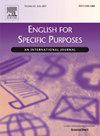An examination of the use of spoken interactional metadiscourse markers in EMI lectures from different disciplines
IF 2.7
1区 文学
Q1 LINGUISTICS
引用次数: 0
Abstract
The internationalisation process has encouraged the spread of English-medium instruction (EMI) in universities all over the world. Whereas the purported benefits of EMI are more often than not taken for granted, there are many issues related to what is actually happening in EMI classrooms that still need to be looked into. In this vein, the use of interactional metadiscourse markers when delivering content in the lingua franca and the potential impact of the disciplinary culture are two issues that have hitherto been largely overlooked. Since research studies indicate that teachers in the arts and social sciences tend to use a higher number of metadiscourse markers than those in the hard sciences, the impact of the discipline in classroom discourse deserves further attention. With a view to fill in this research gap, in this paper we analysed the 29,469 interactional metadiscourse markers found in 36 lectures of three different disciplines, namely economics, engineering and history. The overall distribution of interactional metadiscourse markers revealed that engagement markers happened to be the dominant category by an ample margin, followed by self-mentions, hedges, boosters and attitudes markers. In addition, statistically significant differences were found in the use of interactional markers across the three disciplines, a fact that should be considered in professional development courses. The pedagogical implications to be drawn from these findings and some future directions for research are also put forth.
在不同学科的EMI讲座中使用口语互动元话语标记的研究
国际化进程促进了英语教学(EMI)在世界各地大学的普及。尽管EMI所声称的好处往往被认为是理所当然的,但仍有许多与EMI教室实际发生的情况有关的问题需要调查。在这种情况下,在以通用语传递内容时使用互动元话语标记和学科文化的潜在影响是迄今为止在很大程度上被忽视的两个问题。由于研究表明,艺术和社会科学教师比硬科学教师更倾向于使用更多的元话语标记,因此该学科在课堂话语中的影响值得进一步关注。为了填补这一研究空白,本文分析了经济学、工程学和历史学三个不同学科的36场讲座中发现的29,469个互动元话语标记。互动元话语标记的总体分布表明,参与标记恰好是占主导地位的类别,其次是自我提及、模糊限制、助推器和态度标记。此外,在三个学科中,在使用互动标记方面发现了统计上显著的差异,这是专业发展课程中应该考虑的事实。本文还提出了从这些发现中得出的教学意义和未来的研究方向。
本文章由计算机程序翻译,如有差异,请以英文原文为准。
求助全文
约1分钟内获得全文
求助全文
来源期刊

English for Specific Purposes
LINGUISTICS-
CiteScore
5.70
自引率
8.00%
发文量
41
审稿时长
62 days
期刊介绍:
English For Specific Purposes is an international peer-reviewed journal that welcomes submissions from across the world. Authors are encouraged to submit articles and research/discussion notes on topics relevant to the teaching and learning of discourse for specific communities: academic, occupational, or otherwise specialized. Topics such as the following may be treated from the perspective of English for specific purposes: second language acquisition in specialized contexts, needs assessment, curriculum development and evaluation, materials preparation, discourse analysis, descriptions of specialized varieties of English.
 求助内容:
求助内容: 应助结果提醒方式:
应助结果提醒方式:


